
Pentatomidae is a family of insects belonging to the order Hemiptera, generally called shield bugs or stink bugs. Pentatomidae is the largest family in the superfamily Pentatomoidea, and contains around 900 genera and over 4700 species. As hemipterans, the pentatomids have piercing sucking mouthparts, and most are phytophagous, including several species which are severe pests on agricultural crops. However, some species, particularly in the subfamily Asopinae, are predatory and may be considered beneficial.

Bandwings, or band-winged grasshoppers, are the subfamily Oedipodinae of grasshoppers classified under the family Acrididae. They have a worldwide distribution and were originally elevated to full family status as the Oedipodidae. Many species primarily inhabit xeric weedy fields, and some are considered to be important locusts:
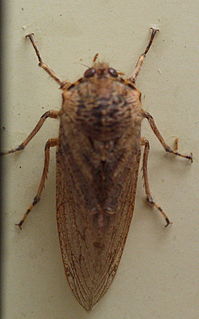
The Tettigarctidae, known as the hairy cicadas, are a small relict family of primitive cicadas. Along with more than 20 extinct genera, Tettigarctidae contains a single extant genus, Tettigarcta, with two extant species, one from southern Australia and one from the island of Tasmania. Fossil taxa include Paratettigarcta from the Miocene of New Zealand, Meuniera from the Paleocene of France, and Sanmai from the Late Jurassic of China, and Maculaferrum of early Late Cretaceous Canada.Tettigarcta are the closest living relatives of the true cicadas.

Delphacidae is a family of planthoppers containing about 2000 species, distributed worldwide. Delphacids are separated from other "hoppers" by the prominent spur on the tibia of the hindleg.
Ingentidens is an extinct genus of chroniosuchid reptiliomorph from upper Permian mudstone deposits of Dashankou locality, Xidagou Formation of China. It was first named by Jin-Ling Li and Zheng-Wu Cheng in 1999, from a mandible. The type species is Ingentidens corridoricus. The generic name means “large” + “tooth” (dens), and the specific name referring to the region of Gansu, the Hexi Corridor where the type specimen was found.
Phratochronis is an extinct genus of chroniosuchid reptiliomorph from upper Permian mudstone deposits of Dashankou locality, Xidagou Formation of China. It was first named by Jin-Ling Li and Zheng-Wu Cheng in 1999, from a maxilla and premaxilla with almost complete dentition. The type species is Phratochronis qilianensis. The generic name means “brothers of a clan” + “late” in reference to its taxonomic position, and the specific name referring to the chain of mountains where the type specimen was found.

Eurydema is a genus of shield bug in the family Pentatomidae.
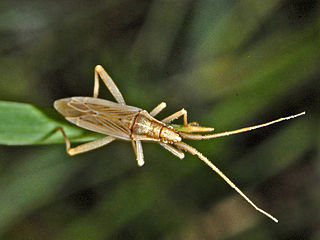
Stenodema is a genus of Palaearctic, Oriental and Nearctic plant bugs in the family Miridae and the tribe Stenodemini.
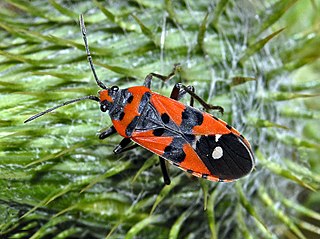
Lygaeus is a genus of seed bugs in the family Lygaeidae. There are more than 60 described species in Lygaeus.

Scolopostethus is a genus of dirt-colored seed bugs in the family Rhyparochromidae. There are more than 30 described species in Scolopostethus.
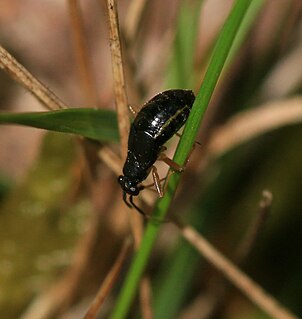
Mecomma is a genus of plant bugs in the family Miridae. There are more than 30 described species in Mecomma.

Monalocoris is a genus of plant bugs in the family Miridae. There are about 19 described species in Monalocoris.
Miasa is an planthopper genus in the family Dictyopharidae. Currently, seven species are identified in the genus. They are distributed in the Oriental regions of Indonesia, Malaysia, China (Yunnan), Thailand, Vietnam, Singapore and Myanmar.

Odontomantis is a genus of mantids in the family Hymenopodidae; species can be found in tropical Asia.
Chlorophlaeoba is a genus of grasshoppers in the family Acrididae, subfamily Acridinae. Species can be found in southern China and Indo-China.
Mengla dianlovirus is a type of filovirus identified in a Rousettus bat in Mengla County, Yunnan Province, China and first reported in January 2019. It is classified in the same family as Ebolavirus and Marburgvirus.
Pilaira is a genus of zygote fungi described in 1875.
Bathycoelia is a genus of shield bugs in the subfamily Pentatominae and the monotypic tribe Bathycoeliini.

Pachygrontha is a genus of seed bugs and allies in the family Pachygronthidae. There are more than 30 described species in Pachygrontha.
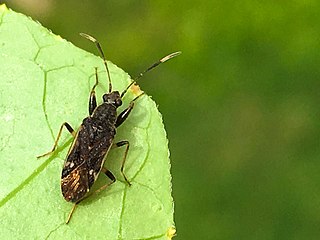
Horridipamera is a genus of dirt-colored seed bugs in the family Rhyparochromidae. There are about 13 described species in Horridipamera.














